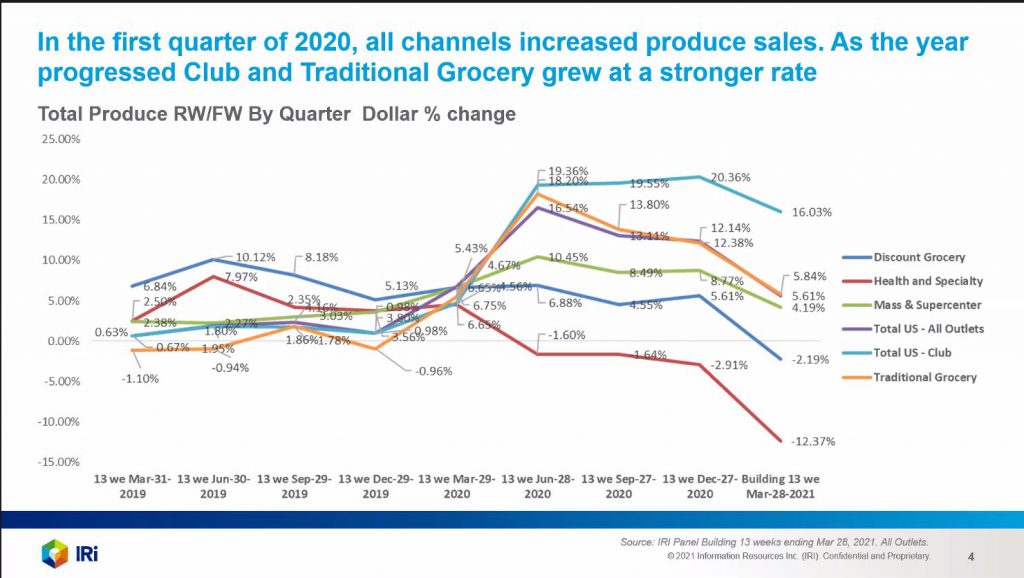
Marketing fresh produce in 2021 is different than 2020 and 2019, and there’s no going back.
During a Produce Marketing Association town hall on consumer trends May 5, three analysts used data to show the unique time we’re in, and how that presents good opportunities for fresh produce sales.
Jonna Parker, principal at IRI Center for Excellence, said traditional grocery stores were the star of pandemic retail shopping, with 2020 Q2 produce sales almost 20 percent higher year over year.
But consumer behaviors are shifting again with nearly all grocery segments dropping below 5 percent year-over-year growth, except for club stores.

“The pandemic brought a new category: the confident cook,” Parker said, noting consumers learned that cooking at home lets them better control ingredients and reduce costs.
“That’s good for produce,” she said.
Tom Rees, food industry manager at Euromonitor International, agrees that the pandemic has permanently changed consumers’ relationships with food.
He said consumers are realizing that being obese and unhealthy is even more risky during this COVID-19 pandemic.

As for the turbulent economy of the last year, it’s not as simple as saying that consumers will spend more on food when they have more money.
Rees said, for instance, higher income consumers spent more money in foodservice and were willing to pay a premium at retail to recreate the restaurant experience.
Meanwhile, lower income consumers didn’t spend as much at foodservice, but were more likely to buy value or private label due to financial trouble.
In the future, he said, value and private label should thrive, and as higher income consumers return to restaurants, there will be lower demand for premium brands at retail.
Brian Numainville, principal at Retail Feedback Group, said not only did online grocery growth accelerate in the past year, so did dual channel shopping (consumers who bought in-store and online in the past 30 days).
He said his biggest message would be for retailers to concentrate more on differentiation and really emphasize what makes them unique in the space.
Parker said an IRI survey in the first quarter of 2021 shows consumers are generally happy with their preferred retailer’s selection of fresh produce.
The most popular drivers of why they choose a grocery store are fresh and well-stocked produce department; seasonal produce offerings; both bulk and packaged options; and locally grown produce.
The survey said the most popular ways consumers say they will try new fruits or vegetables are by learning about their nutritional benefits and a new recipe application.
Marketing fresh produce in 2021 is different than 2020 and 2019, and there’s no going back.
During a Produce Marketing Association town hall on consumer trends May 5, three analysts used data to show the unique time we’re in, and how that presents good opportunities for fresh produce sales.
Jonna Parker, principal at IRI Center for Excellence, said traditional grocery stores were the star of pandemic retail shopping, with 2020 Q2 produce sales almost 20 percent higher year over year.
But consumer behaviors are shifting again with nearly all grocery segments dropping below 5 percent year-over-year growth, except for club stores.

“The pandemic brought a new category: the confident cook,” Parker said, noting consumers learned that cooking at home lets them better control ingredients and reduce costs.
“That’s good for produce,” she said.
Tom Rees, food industry manager at Euromonitor International, agrees that the pandemic has permanently changed consumers’ relationships with food.
He said consumers are realizing that being obese and unhealthy is even more risky during this COVID-19 pandemic.

As for the turbulent economy of the last year, it’s not as simple as saying that consumers will spend more on food when they have more money.
Rees said, for instance, higher income consumers spent more money in foodservice and were willing to pay a premium at retail to recreate the restaurant experience.
Meanwhile, lower income consumers didn’t spend as much at foodservice, but were more likely to buy value or private label due to financial trouble.
In the future, he said, value and private label should thrive, and as higher income consumers return to restaurants, there will be lower demand for premium brands at retail.
Brian Numainville, principal at Retail Feedback Group, said not only did online grocery growth accelerate in the past year, so did dual channel shopping (consumers who bought in-store and online in the past 30 days).
He said his biggest message would be for retailers to concentrate more on differentiation and really emphasize what makes them unique in the space.
Parker said an IRI survey in the first quarter of 2021 shows consumers are generally happy with their preferred retailer’s selection of fresh produce.
The most popular drivers of why they choose a grocery store are fresh and well-stocked produce department; seasonal produce offerings; both bulk and packaged options; and locally grown produce.
The survey said the most popular ways consumers say they will try new fruits or vegetables are by learning about their nutritional benefits and a new recipe application.
Greg Johnson is Director of Media Development for Blue Book Services





